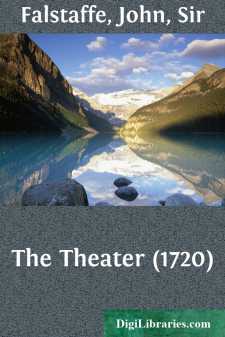Categories
- Antiques & Collectibles 13
- Architecture 36
- Art 48
- Bibles 22
- Biography & Autobiography 813
- Body, Mind & Spirit 142
- Business & Economics 28
- Children's Books 15
- Children's Fiction 12
- Computers 4
- Cooking 94
- Crafts & Hobbies 4
- Drama 346
- Education 46
- Family & Relationships 57
- Fiction 11828
- Games 19
- Gardening 17
- Health & Fitness 34
- History 1377
- House & Home 1
- Humor 147
- Juvenile Fiction 1873
- Juvenile Nonfiction 202
- Language Arts & Disciplines 88
- Law 16
- Literary Collections 686
- Literary Criticism 179
- Mathematics 13
- Medical 41
- Music 40
- Nature 179
- Non-Classifiable 1768
- Performing Arts 7
- Periodicals 1453
- Philosophy 64
- Photography 2
- Poetry 896
- Political Science 203
- Psychology 42
- Reference 154
- Religion 513
- Science 126
- Self-Help 84
- Social Science 81
- Sports & Recreation 34
- Study Aids 3
- Technology & Engineering 59
- Transportation 23
- Travel 463
- True Crime 29
The Theater (1720)
by: John Falstaffe
Description:
Excerpt
INTRODUCTION
The Theatre, by "Sir John Falstaffe", is according to its author a continuation of Richard Steele's periodical of the same name. Shortly after Steele brought his paper to a close on April 5, 1720, the anonymous author who called himself "Falstaffe" appropriated his title; or if we prefer Falstaffe's own account of the matter, he was bequeathed the title upon the decease of Steele's "Sir John Edgar". At any rate, the new series of Theatres was begun on April 9, 1720, and continued to appear twice a week for eleven numbers until May 14. On Tuesdays and Saturdays Falstaffe entertained the town with a pleasant essay in the tradition established by The Tatler.
But the paper of April 9, the first of the new Theatres, was only nominally the first of a series; Falstaffe, who numbered the paper "sixteen", had already written fifteen papers called The Anti-Theatre in answer to Steele's Theatre. The demise of Steele's periodical merely afforded him an opportunity of changing his title; his naturally became inappropriate when Steele's paper was discontinued and the shorter title was probably thought to be more attractive to readers. Falstaffe made no attempt to pass his papers off as the work of his famous rival, to gain popularity for them through the reputation of Steele. Indeed, the antagonism which existed between the two men would have made such an act of deception an unlikely one.
Steele's The Theatre, his last periodical, had been written for a controversial purpose; by his own admission he wrote it to arouse support for himself in a dispute in which he was engaged with the Lord Chamberlain, the Duke of Newcastle. Steele, who by the authority of a Royal Patent was governor of the Company of Comedians acting in Drury Lane, insisted that his authority in the theatre was not respected by the Lord Chamberlain, the officer of the Royal Household traditionally charged with supervision of theatrical matters. Newcastle intervened in the internal affairs of Drury Lane and, when Steele protested, expelled him from the theatre. Steele could do nothing but submit, though he retaliated with a series of bitter attacks on the Duke in The Theatre.
Newcastle found defenders, of whom one of the strongest was Falstaffe, who wrote in direct opposition to Steele's "Sir John Edgar", openly attempting to provoke that knight to a journalistic contest. But Edgar gave scant attention to his essays, though they were vigorously written and presented strong arguments in defense of the Lord Chamberlain's intervention in Drury Lane affairs. Steele acknowledged the first number of The Anti-Theatre (it appeared on February 15, 1720) in the fourteenth number of his own paper, praising Falstaffe for his promise not to "intrude upon the private concerns of life" in the debate which was to follow, but thereafter he all but ignored his new rival. With the exception of a brief allusion in The Theatre, No. 17 (an allusion which Falstaffe was quick to take up), Steele made no more references to the other periodical....


